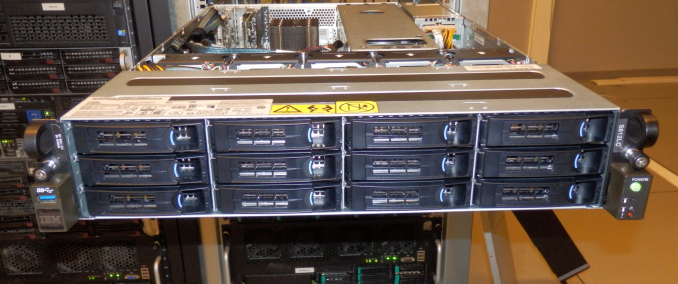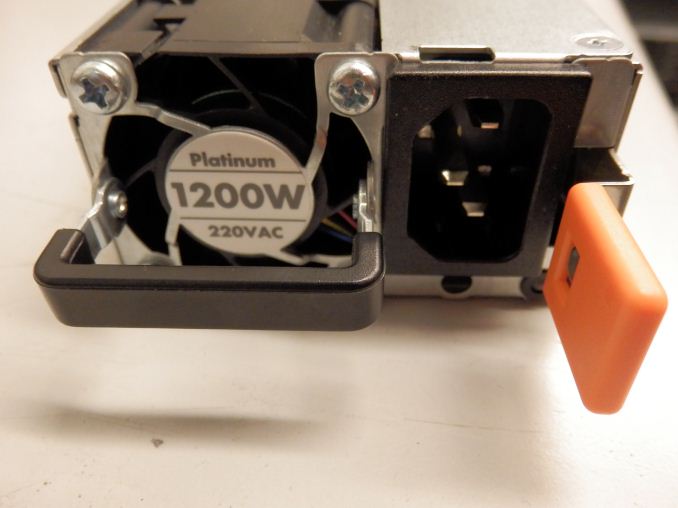Assessing IBM's POWER8, Part 2: Server Applications on OpenPOWER
by Johan De Gelas on September 15, 2016 8:01 AM ESTBack to the Present: Real World Application Benchmarking on IBM's S812LC
As promised in the first part of our series on evaluating the POWER8, we got busy benchmarking real server applications. The latest IBM servers were not available to us yet, but we can still show some interesting benchmarks as the S812LC has a 10-core POWER8 CPU running at 2.92 GHz (and boosting to 3.5 GHz).
This single chip POWER8 is the same processor that power the new "IBM S822LC for big data" and "S822LC for HPC".
And although it is not the latest and greatest, the S812LC is still an interesting server. It is the most affordable IBM POWER8 server in a very long time and offers some unique features. 32 DIMMs allow you get up to 1TB of DRAM (32 x 32 GB) without the need for disproportionally expensive 64 GB DIMMs. Two rear disk expansion bays offer 2 bays for booting the server (in RAID-1 if you like) and make sure that the 12 front bays can be used for data only. The system supports 6 TB SATA disks or 960 GB SSDs (Samsung).
Two redundant Platinum-brand 1200W PSUs feed the server build for big data.












49 Comments
View All Comments
loa - Monday, September 19, 2016 - link
This article neglects one important aspect to costs:per-core licensed software.
Those licenses can easily be north of 10 000$ . PER CORE. For some special purpose software the license cost can be over 100 000 $ / core. Yes, per core. It sounds ridiculous, but it's true.
So if your 10-core IBM system has the same performance as a 14-core Intel system, and your license cost is 10 000$ / core, well, then you just saved yourself 40 000 $ by using the IBM processor.
Even with lower license fee / core, the cost advantage can be significant, easily outweighing the additional electricity bill over the lifetime of the server.
aryonoco - Tuesday, September 20, 2016 - link
Thanks Johan for another very interesting article.As I have said before, there is literally nothing on the web that compares with your work. You are one of a kind!
Looking forward to POWER 9. Should be very interesting.
HellStew - Tuesday, September 20, 2016 - link
Good article as usually. Thanks Johan.I'd still love to see some VM benchmarks!
cdimauro - Wednesday, September 21, 2016 - link
I don't know how much value could have the performed tests, because they don't reflect what happens in the real world. In the real world you don't use an old o.s. version and an old compiler for an x86/x64 platform, only because the POWER platform has problems with the newer ones. And a company which spends so much money in setting up its systems, can also spend just a fraction and buy an Intel compiler to squeeze out the maximum performance.IMO you should perform the tests with the best environment(s) which is available for a specific platform.
JohanAnandtech - Sunday, September 25, 2016 - link
I missed your reaction, but we discussed this is in the first part. Using Intel's compiler is good practice in HPC, but it is not common at all in the rest of the server market. And I do not see what an Intel compiler can do when you install mysql or run java based applications. Nobody is running recompiled databases or most other server software.cdimauro - Sunday, October 2, 2016 - link
Then why you haven't used the latest available distro (and compiler) for x86? It's the one which people usually use when installing a brand new system.nils_ - Monday, September 26, 2016 - link
This seems rather disappointing, and with regards to optmized Postgres and MariaDB, I think in that case one should also build these software packages optimized for Xeon Broadwell.jesperfrimann - Thursday, September 29, 2016 - link
@nils_Optimized for.. simply means that the software has been officially ported to POWER, and yes that would normally include that the specific accelerators that are inside the POWER architecture now are actually used by the software, and this usually means changing the code a bit.
So .. to put it in other words .. just like it is with Intel x86 Xeons.
// Jesper
alpha754293 - Monday, October 3, 2016 - link
I look forward to your HPC benchmarks if/when they become available.